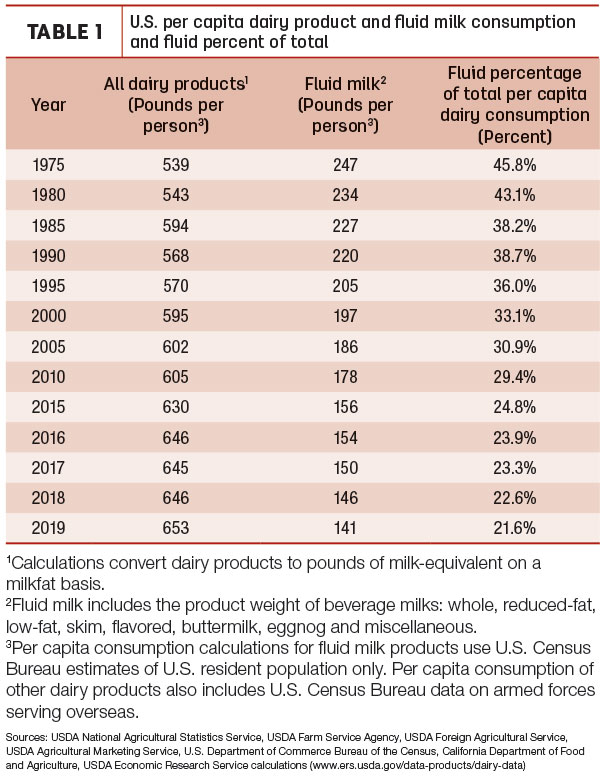The USDA data shows 2019 U.S. per capita consumption of dairy products (on a milk-equivalent, milkfat basis) increased 7 pounds from the 2018’s revised estimate to 653 pounds (Table 1). It was the fourth-largest annual increase in the past decade.

Per capita dairy product consumption jumped 37 pounds in the past five years, from 616 pounds in 2014 to 653 pounds in 2019.
Fluid milk trend continues
While overall per capita dairy product consumption trended upward, consumption of fluid products has declined both in terms of volume and as a percentage of total dairy product consumption.
U.S. per capita consumption of fluid milk was estimated at 141 pounds in 2019, down 4 pounds from 2018 and down 55 pounds (roughly 6.4 gallons) since 2000.
As a percentage of total U.S. dairy product consumption, fluid beverage milk slipped from nearly 46% in 1975 to under 22% in 2019.
Cheese, butter consumption up again
As in previous years, U.S. consumers are “eating” more dairy: The 2019 decline in fluid milk consumption was more than offset by increased cheese and butter consumption.
The milk equivalent of cheese consumption has been greater than fluid milk since the mid-1980s, and 2019 U.S. cheese consumption (excluding cottage cheese) set another record high, at more than 38 pounds per person.
American cheese consumption rose to about 15.5 pounds per capita in 2019, up 0.1 pound from the year before. Consumption of other cheeses rose about 0.2 pound to 22.8 pounds per person. Per capita consumption of cheese increased in 30 of the last 31 years and has declined only twice since 1975, in 1988 and 2008.
Per capita consumption of butter (6.2 pounds) rose 0.2 pound in 2019. After posting annual declines for most of the last quarter of the 1900s, annual per capita butter consumption has now increased or held steady since 2002, with an overall increase of almost 2 pounds per person during that period.
Other products mixed
However, consumption of yogurt (other than frozen) declined 0.2 pound from 2018 to 13.4 pounds. After peaking in 2013-14, per capita yogurt consumption has now dipped 1.5 pounds in the past five years.
Per capita consumption of other dairy products was mixed: Regular ice cream was up slightly, while low-fat and nonfat ice cream was unchanged; consumption of dry nonfat milk and skim milk powder rose; and consumption of dry whey and whey protein concentrates also increased.
More turning back to whole milk
Total U.S. fluid milk sales in 2019, estimated at 46.4 billion pounds, were down 828 million pounds from 2018 and down nearly 4 billion pounds since 2014. However, U.S. consumers are increasingly returning to whole milk, with total sales volume up for a sixth consecutive year. Total U.S. sales of whole milk topped 16 billion pounds for the first time since 2007 (last year’s estimate was revised below that level). That increase wasn’t enough to offset sales declines in reduced-fat (2%), low-fat (1%) and skim milk.
Overall sales of flavored milk declined for a second year in a row despite a 72-pound increase in sales of flavored whole milk compared to the year before.
Organic milk represented about 5.6% of all fluid milk product sales in 2019.
The number of plants processing fluid milk in 2019 decreased by 13 to 445, but the average milk volume per plant increased about 1 million pounds to 104.3 million pounds per year. ![]()

-
Dave Natzke
- Editor
- Progressive Dairy
- Email Dave Natzke







